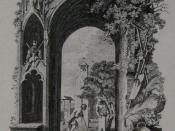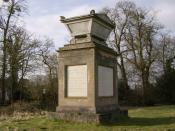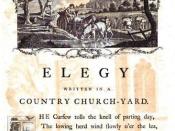Often, John Milton's Elegy and Thomas Gray's "Elegy Written in a Country Churchyard" have been compared. Many believe that Milton's Elegy influenced Gray's Elegy. While the two Elegies' have a lot in common, they are still very different. Using literary elements, such as imagery, tone, and the use of pathetic fallacy, this essay will show that Milton's Elegy is superior to Gray's.
Imagery is very important in a poem, novel, or elegy. It allows the reader to picture the work in his or hear mind as he or she read. The imagery in Milton's Elegy is of nature and flowers. This imagery sets the scene, and allows the reader to picture the events as happening in a rural, rustic setting. He often describes the many types of flowers and plants. One such instance is when the speaker, Milton, becomes angry at nature and terrorizes it. "Ye myrtles brown, with ivy never sere,/I come to pluck your berries harsh and crude," (lines 2-3).
He is angry that his friend is gone, and takes it out on nature by ripping off leaves and plucking off the berries. Milton, though terrorizing nature, is also describing it and this description thus adds to the imagery of the work.
Gray's elegy is set in the graveyard, and the imagery, therefore, is more bleak, dark, and murky. When describing the dead buried under the trees, Gray states that "Beneath those rugged elms, that yew-trees shade,/Where heaves the turf in many a mould'ring heap/Each in his narrow cell for ever laid,/The rude forefathers of a hamlet sleep." This is saying that the dead are buried under withering trees, laid to rest in the dirt forever more. Milton's elegy is superior than gray's simply because the imagery of Milton's piece makes for a more...


